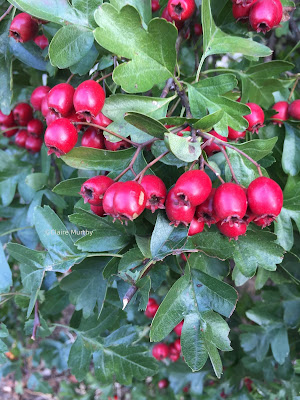Autumn Hawthorn Berries in the Kitchen Garden
It's late September and the hawthorn leaves are starting their seasonal change from the rich green fresh leaves of late Spring to the dry-looking, brown-edged, somewhat disheveled leaves that signify the early stages of Autumn.
The term 'haw' is an old English term meaning hedge and hawthorn berries are an important and attractive feature of the British native hedgerow; there are certainly hawthorns in many London parks and gardens, Kent and Surrey countryside and hedgerows.
Haws have a place in both the wildlife garden, as they provide good shelter and nutritious food for birds and other countryside animals, as well as the kitchen garden - for they are largely edible.
From their flowers and young leaves to their berries that have a pungent zing of over-ripe apples, they are a very edible addition to kitchen garden, and as with the many other delights of this kitchen garden - they grow themselves!
They have many culinary uses from hawthorn jelly or wine to haw fruit leather sweets or salad leaves and berries (seeds removed); they may well find a place in the kitchen again this season.
Whether to cook them or paint them is the challenge; a vase of hawthorn stalks with those green leaves and berries looks attractive on the window-sill and plenty are left for the wildlife!
It's late September and the hawthorn leaves are starting their seasonal change from the rich green fresh leaves of late Spring to the dry-looking, brown-edged, somewhat disheveled leaves that signify the early stages of Autumn.
The term 'haw' is an old English term meaning hedge and hawthorn berries are an important and attractive feature of the British native hedgerow; there are certainly hawthorns in many London parks and gardens, Kent and Surrey countryside and hedgerows.
Haws have a place in both the wildlife garden, as they provide good shelter and nutritious food for birds and other countryside animals, as well as the kitchen garden - for they are largely edible.
 |
| Autumn : Hawthorn Berries in the Kitchen Garden |
From their flowers and young leaves to their berries that have a pungent zing of over-ripe apples, they are a very edible addition to kitchen garden, and as with the many other delights of this kitchen garden - they grow themselves!
They have many culinary uses from hawthorn jelly or wine to haw fruit leather sweets or salad leaves and berries (seeds removed); they may well find a place in the kitchen again this season.
Whether to cook them or paint them is the challenge; a vase of hawthorn stalks with those green leaves and berries looks attractive on the window-sill and plenty are left for the wildlife!